Dell XPS 410: Core 2 Duo for the Masses
by Jarred Walton on September 18, 2006 12:20 PM EST- Posted in
- Systems
Externals and Appearance
We said that the 2407WFP display is probably the most impressive part of the configuration we were sent for testing. However, the system design is really good as well. Almost everything is completely tool-less, and accessing the internals and changing components is extremely easy. Let's start with the outward appearance first.
In a break from tradition, the case is all white with the Dell logo embossed on the sides. After seeing many beige, black, and varying other colors of cases, the pure white design is a nice change. Some might say that Dell seems to be copying the white appearance of Apple's iMac computers, but if you are looking to copy aesthetics there are far worse choices than Apple.
The front panel is a more traditional design, with black drive bays set in a silver mold. At the top of the case is a chrome XPS 410 logo, and at the bottom are the air intakes for one of the internal fans. Above the Dell logo, you can see the power switch, and you also have access to the front audio ports, two USB ports, and a FireWire port (provided you get the optional FireWire PCI card).
The left and right sides of the case are virtually mirror images of each other. The only difference is that the right side has some ventilation slots at the bottom of the case. If you're wondering about the black cutout towards the front of the case, that is part of the BTX design Dell has used. This provides an air intake for the main 120mm fan that cools the CPU heatsink and also provides ventilation to the inside of the case. Some form of ducting could have been used instead, so the cutout seems to be more for adding visual flair than because it was absolutely required.
Besides the typical connectors you would find at the rear of any PC, there are a few interesting points about the Dell XPS 410. First, note how there's a huge ventilated area in the middle section of the case. This matches up with the 120mm fan located at the front of the case, with the CPU heatsink sitting in the middle. Basically, this provides a great way for getting all of the hot air generated by the CPU and other components out of the system. You can also see that the standard I/O panel is dramatically different from what most people are used to. There are no PS/2 keyboard or mouse ports, nor are there serial or parallel ports. Instead, you get six USB 2.0 ports, a Gigabit Ethernet port, and an S/PDIF optical out connection. Above the S/PDIF port are the audio ports, which are hidden by a small cover by default. If you use the system as an entertainment center PC, the optical out would be the preferred connection, though most people will more than likely use analog speakers.
The last two items worth noting on the rear of the case are better viewed from a different angle. At the top you can see the latch that pops open the right side of the case. This makes it extremely easy to open up the system for upgrades or maintenance. At the bottom just above the expansion card slots you can see a protruding hinge. We will take a closer look at how this works when we get to the internals next, but basically it's part of the tool-less design that allows you to install or remove expansion cards very easily.
We said that the 2407WFP display is probably the most impressive part of the configuration we were sent for testing. However, the system design is really good as well. Almost everything is completely tool-less, and accessing the internals and changing components is extremely easy. Let's start with the outward appearance first.
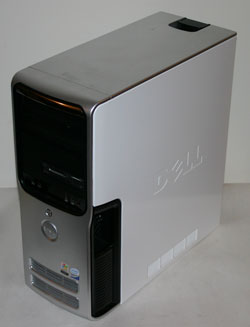 |
| Click to enlarge |
In a break from tradition, the case is all white with the Dell logo embossed on the sides. After seeing many beige, black, and varying other colors of cases, the pure white design is a nice change. Some might say that Dell seems to be copying the white appearance of Apple's iMac computers, but if you are looking to copy aesthetics there are far worse choices than Apple.
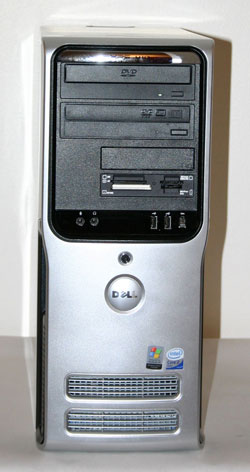 |
| Click to enlarge |
The front panel is a more traditional design, with black drive bays set in a silver mold. At the top of the case is a chrome XPS 410 logo, and at the bottom are the air intakes for one of the internal fans. Above the Dell logo, you can see the power switch, and you also have access to the front audio ports, two USB ports, and a FireWire port (provided you get the optional FireWire PCI card).
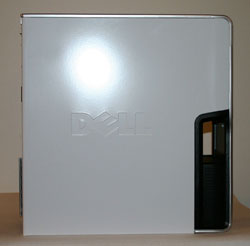 |
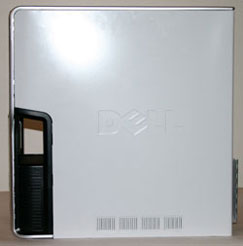 |
| Click to enlarge | |
The left and right sides of the case are virtually mirror images of each other. The only difference is that the right side has some ventilation slots at the bottom of the case. If you're wondering about the black cutout towards the front of the case, that is part of the BTX design Dell has used. This provides an air intake for the main 120mm fan that cools the CPU heatsink and also provides ventilation to the inside of the case. Some form of ducting could have been used instead, so the cutout seems to be more for adding visual flair than because it was absolutely required.
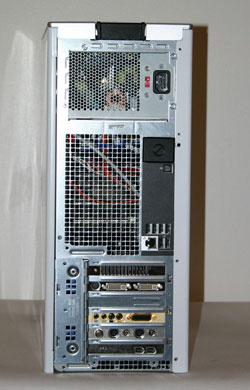 |
| Click to enlarge |
Besides the typical connectors you would find at the rear of any PC, there are a few interesting points about the Dell XPS 410. First, note how there's a huge ventilated area in the middle section of the case. This matches up with the 120mm fan located at the front of the case, with the CPU heatsink sitting in the middle. Basically, this provides a great way for getting all of the hot air generated by the CPU and other components out of the system. You can also see that the standard I/O panel is dramatically different from what most people are used to. There are no PS/2 keyboard or mouse ports, nor are there serial or parallel ports. Instead, you get six USB 2.0 ports, a Gigabit Ethernet port, and an S/PDIF optical out connection. Above the S/PDIF port are the audio ports, which are hidden by a small cover by default. If you use the system as an entertainment center PC, the optical out would be the preferred connection, though most people will more than likely use analog speakers.
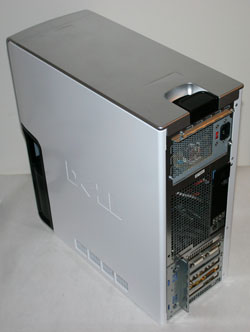 |
| Click to enlarge |
The last two items worth noting on the rear of the case are better viewed from a different angle. At the top you can see the latch that pops open the right side of the case. This makes it extremely easy to open up the system for upgrades or maintenance. At the bottom just above the expansion card slots you can see a protruding hinge. We will take a closer look at how this works when we get to the internals next, but basically it's part of the tool-less design that allows you to install or remove expansion cards very easily.










50 Comments
View All Comments
Gary Key - Monday, September 18, 2006 - link
BF2 is just a bit weird with the benchmark results. Although our demo contains several minutes of intense action on the Daqing Oilfield map in a variety of vehicles and personnel assignments we typically find there is very little difference in the benchmarks between 1600x1200/1680x1050 or 1920x1200/1920x1440 resolutions with a decent video card. Also, with the latest video cards like the 7900GTX or X1900 there is no penalty now for 4xAA at 1280x1024 as an example. The benchmark will score the same as we are not GPU limited at that resolution with the Dell configuration as an example.
JarredWalton - Monday, September 18, 2006 - link
BF2 also doesn't properly support WS formats except in demo playback. Go figure. So perhaps it isn't properly optimized for aspect ratios other than 1.333 (the standard for 4:3 displays).giantpandaman2 - Monday, September 18, 2006 - link
Thoroughly enjoyed it. :)Again, only suggestion would be to add how long it took between ordering and receiving.
bamacre - Monday, September 18, 2006 - link
I've been telling everyone how well-designed these cases are, and how powerful the PSU's are. I stuck an X1900 XTX card in a precision 390 with a 375W PSU, and it ran great. People don't understand wattage isn't everything.And, I totally agree, I wish case manufacturers would take a peek and learn a few things from the higher-end Dell cases.
Again, great job on the review.
yyrkoon - Monday, September 18, 2006 - link
Dell cases suck, however thier cases work for thier systems very well. Dell has always(atleast for the last several years) had innovative ways of cooling thier systems, I'm a bit surprised I even saw a radiator in this system, because normally, with a normal heatsink, and thier exaust shroud, thier systems run pretty dahmed cool.Anyhow, if you REALLY think thier cases are great, buy a Lian Li, then think on it again :) All it takes for me to realize it sucks, is to look at the back of the case, and notice how cheap it is.
Dell makes great computers for people who dont want to build thier own systems, however, for those of us who do build our own systems, I think all of us would agree, that nothing is better than a hand built system. You wont, however, be able to beat Dell prices (latest Dell catelog showed thier rock bottom system selling for $399 us, including a 17" LCD !)
mino - Monday, September 18, 2006 - link
For sinle C2D, 2sticks generi DDR2, single X1900XTX, dual HDD and dual optical ANY _properly_designed_ 350W PSU is sufficient.The real issu is, these times 300W != 300W, thats the real issue.
As a fact wattage matters, however the real one, not the written one...
kristof007 - Monday, September 18, 2006 - link
I really enjoyed reading through the review. So I was wondering would you be able to take that supporting piece off the 7900 and snap it onto a gfx card you buy?JarredWalton - Monday, September 18, 2006 - link
The blue plastic is basically made to hold a GPU in place and it should work with any standard GPU. Some specialized cooling solutions won't fit most likely, but I did slot in an X1900XT card and it fit without problems.Homerboy - Monday, September 18, 2006 - link
I'm so sick of the standard, anti-big-box-company rhetoric that's thrown aroung the Anantech Forums. Maybe this will quiet their tone.mino - Monday, September 18, 2006 - link
In the US, Absolutelly True.Here, in Slovakia, Central Europe, NO.
Simply because the smaller the market, the more expensive the Dell and the worse the support.
We buy no pre-built ones since the for a price on an low-end pre-build I can have mid-to-high end custom build.
And local support -if knowledgeable- is FAR more effective and responsive that any DELL's. Not to mention cheaper, since most HW issues are warrantied even on customs. The real problem's are HW-SW and SW and most of these are not warrantied by anybody, so you are gonna solve them by yourself or pay huge sums for paid support.
Here the ~$200 per incident from big players is outrageous. Such can pay me 2-3 days of on-site professional's salary. And I need that professional no matter what.
Those Dell's prices are cute, if one forgets they ask $1000 here for the same machine sold at $500 in US... That puts thing a bit into the perspective.
Also to maintain an stable of a few hundred of those machines >3yrs often becomes a real pain.
Reason being 1GHz/512M Athlon/PIII from 2001 is still pretty sufficient for most of the tasks these days, also budgetary constriants are never predictable...
As of now, I simply buy 30% motherboards above the PC count and I'm pretty nicely covered for 5+yrs. 3yrs is warranty, and after that I have own spare parts stacked up nicely on the self.
Any other part is a comodity thingie, som almost no stockpile needed.
This way we can repair any HW failure within minutes of diagnose and if needed pretty comfortably operate for a few yers under seriosly limited budget.
So for me - screw the Dell's of this world :)